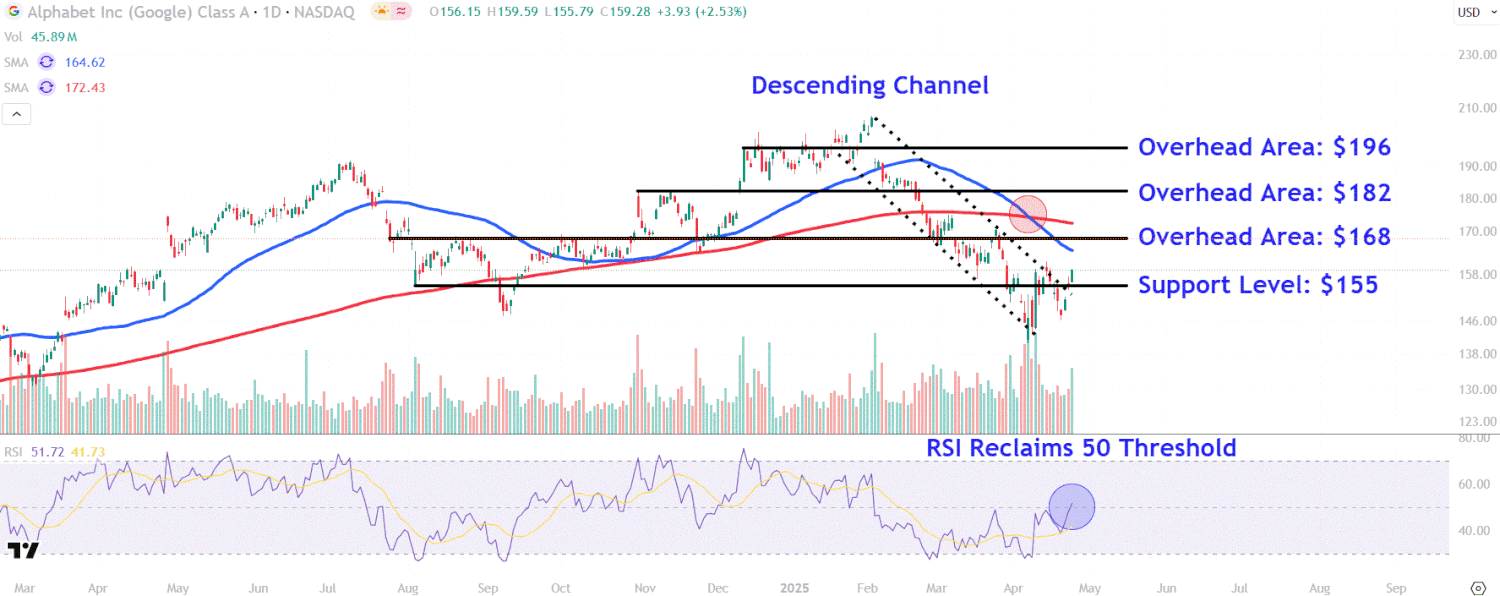How close are we to trade deals? … a potential redefinition of a “deal” … invest in the “Iron Law” with Louis Navellier … a no-brainer investment with “mine, baby, mine”
Since April 8 – the day before President Trump announced a 90-day pause on reciprocal tariffs – stocks have soared.
As I write Friday early-afternoon, the Dow has added about 6%. The S&P is up 10%. And the Nasdaq has rallied roughly 13%.
The cannonball back into the market represents a wager from investors. They’re putting their chips on one specific outcome…
Trade deals will be announced soon, and they’ll be economically beneficial – or at a minimum, not overly destructive.
As with all wagers, there’s risk. In this case, there are two potential tripwires:
- The deals don’t actually materialize
- The deals that do materialize disappoint Wall Street
To illustrate the first risk, let’s look at Japan.
Initially, trade experts expected a deal would materialize rather quickly. On the 17th, President Trump touted “big progress” in trade talks with Japanese trade officials.
However, when Ryosei Akazawa, Japan’s economic revitalization minister, arrived back in Tokyo, he told local press:
I made clear to the U.S. that we feel the tariff measures are extremely regrettable. I strongly urged them to reconsider these policies.
Today, headlines suggest a deal is imminent, but when I dig into the details, substantive issues remain – notably Japan’s reluctance to take part in a U.S.-led economic bloc aligned against China, its largest trading partner.
Meanwhile, it’s unclear how close the White House is to deals when it reports “progress.”
For example, on Wednesday, Treasury Secretary Scott Bessent said the Trump administration has an “opportunity for a big deal” on trade between the U.S. and China.
But yesterday, a Ministry of Commerce spokesperson threw cold water on that idea, saying:
At present there are absolutely no negotiations on the economy and trade between China and the U.S.
But the greater risk to our market rally is the second potential tripwire – trade “deals” arrive, but not in the form Wall Street wants
Time’s interview with President Trump, published earlier today, provides an illustration (annotated):
Interviewer: We’re now 13 days into the point from when you lifted the reciprocal, the discounted reciprocal tariffs. There’s zero deals so far. Why is that?
Trump: No, there’s many deals.
Interviewer: Not one has been announced yet. When are you going to announce them?
Trump: I’ve made 200 deals.
Interviewer: Can you share with whom?
Trump: Because the deal is a deal that I choose. View it differently: We are a department store, and we set the price. I meet with the companies, and then I set a fair price, what I consider to be a fair price, and they can pay it, or they don’t have to pay it.
If a trade deal can be whatever the President chooses, then loads of “deals” could maintain some tariff level that negatively impacts Corporate America’s bottom line.
For example, on Wednesday, President Trump’s comments about lower tariffs on China helped fuel this week’s market gains. But included in his statement was:
But [tariffs on China] won’t be zero.
There’s a lot of room between 0% and today’s rate of 145%. Even if Trump takes tariffs down to 50%, it’s likely to have a substantial impact on small U.S. import businesses with razor-thin margins.
For perspective, financial planning platform Vena finds that the average small business profit margin ranges between 7% and 10%. A 50% tariff could do loads of damage. Even a 20% tariff could be painful.
Right on cue, this morning, CNBC reported that Amazon sellers are raising prices:
Amazon merchants are hiking prices for everything from diaper bags and refrigerator magnets to charm necklaces and other top-selling items as they confront higher import costs.
E-commerce software company SmartScout tracked 930 products on Amazon that have seen increased prices since April 9, with an average jump of 29%.
Sellers are now faced with the conundrum of raising prices or eating the extra costs associated with Trump’s new tariffs. It’s an existential threat for many sellers, who subsist on razor-thin margins.
In the meantime, Trump’s 10% blanket tariff, and the uncertainty surrounding higher reciprocal tariffs, continue impacting Wall Street and Main Street
Beginning with Wall Street, here’s Jon Moeller, CEO of consumer goods giant Procter & Gamble, speaking yesterday:
[Tariffs] will cause a challenge, and we’re working to understand the magnitude of what that challenge will be, and how we’ll offset that.
There will likely be pricing [changes] — tariffs are inherently inflationary — but we’re also looking at sourcing options.
Next up, we have PepsiCo CEO Ramon Laguarta from yesterday:
As we look ahead, we expect more volatility and uncertainty, particularly related to global trade developments, which we expect will increase our supply chain costs.
Then, there’s Merck. Yesterday, the drugmaker lowered its profit outlook, partially blaming a $200 million hit from tariffs. From CNBC:
The company said the expected tariff charge primarily reflects levies between the U.S. and China, and Canada and Mexico to a lesser degree.
Shifting to Main Street, yesterday, we learned that fewer Americans are planning to travel this summer.
Survey results from consumer finance company Bankrate show only 46% of respondents are planning summer travel, down from 53% last year. A senior industry analyst at Bankrate cited tariffs and fears of a recession:
We’re seeing…the potential for higher prices, which has many people on edge.
Meanwhile, market research company Numerator recently conducted a survey of U.S. consumers. From its takeaways:
- 85% are concerned about the impact of tariffs on their finances or shopping
- 83% anticipate making changes to their shopping habits in response to tariffs
- 72% are worried about tariffs raising the price of everyday goods
And this morning, The University of Michigan released the glum results of its Consumer Sentiment Survey. From Bloomberg:
US consumer sentiment fell to one of the lowest readings on record and long-term inflation expectations climbed to the highest since 1991 on fears of the economic fallout from tariffs.
Clearly, tariffs and trade war uncertainty are beginning to impact the economy and the consumer. This has us eager for headlines trumpeting signed trade deals – not just “progress” on trade deals.
The good news is in that the same Time article referenced earlier, the President suggested he’ll have wrapped up all the trade deals within the next month…sort of:
Trump: I would say, over the next three to four weeks, and we’re finished, by the way.
Interviewer: You’re finished?
Trump: We’ll be finished.
Interviewer: Oh, you will be finished in three to four weeks.
Trump: I’ll be finished. Now, some countries may come back and ask for an adjustment, and I’ll consider that, but I’ll basically be.
Bottom line: Let’s be clear – this market run-up is a big bet.
But that doesn’t mean investors shouldn’t be making any bets today…
As investors, we’re always making bets. But we recommend that you analyze your wagers through the lens of the “Iron Law” of the stock market.
Here’s legendary investor Louis Navellier with the definition:
Stock price trends can diverge from earnings trends for a while, but over the long-term, if a company grows and grows the amount of cash it takes in, its share price is sure to head higher.
Wednesday brought an example of this law in action when one of Louis’ Growth Investor recommendations, Vertiv Holdings (VRT) popped 9% on strong earnings.
(Disclaimer: I own Vertiv.)
If you’re less familiar, Vertiv is a leading provider of critical infrastructure solutions for data centers, communication networks, and industrial environments.
Here’s Louis:
Not only did Vertiv beat [earnings forecasts], it said the demand for the AI datacenters was very strong.
So Vertiv is going to gap up today. And it’s going to lift all the data center–related stocks.
The gains kept coming yesterday after Amazon and Nvidia executives said the construction of artificial intelligence data centers is not slowing down.
From CNBC:
“There’s been really no significant change,” Kevin Miller, Amazon’s vice president of global data centers, said at a conference organized by the Hamm Institute for American Energy.
“We continue to see very strong demand, and we’re looking both in the next couple years as well as long term and seeing the numbers only going up.”
The gains are continuing today. Between Wednesday and Friday as I write, VRT has jumped 23%. Congrats to all the Growth Investor subscribers out there.
So – yes – keep making bets. But anchor them in the Iron Law of the market, which is what Louis is doing today:
Earnings are working – and earnings are even working when you have bad news…
This is going to be a stunning earnings announcement season for us.
Our average sales are going to be up over 23%, our average earnings are going to be up over 62%, and usually our surprises are substantial. So, whether they’ll be 13%, 15% or so on average – we’ll see.
But so far, so good.
For another informed gamble, put your chips on what our federal government deems to be critical
The U.S. economy is dangerously reliant on China in several areas, but perhaps none more important than rare earth metals, which are critical in many manufacturing and defense sectors.
For readers less familiar, rare earth metals (or elements) are a group of 17 metals that form under the earth’s surface. They can be difficult to find and extract.
These metals contain unique magnetic, heat-resistant, and phosphorescent properties that make them critical for tech-products such as smart phones, digital cameras, computers, LED lights, and flat screen TVs, among others. Basically, they’re the building blocks of all things “technology and AI.”
Now, at the heart of the China/rare earths problem is one thing…
They control them. We don’t.
Here’s the Center for Strategic & International Studies:
At present China produces 60 percent of the world’s rare earths but processes nearly 90 percent, which means that it is importing rare earths from other countries and processing them.
This has given China a near monopoly…
China announced a ban of rare earth extraction and separation technologies on December 21, 2023.
This has significant implications for U.S. national, economic, and rare earth security.
Rare earth elements—a group of 17 metals—are used in defense technologies, including missiles, lasers, vehicle-mounted systems such as tanks, and military communications…
Well, the Trump administration is now considering investing in rare earth mining companies.
From Interior Secretary Doug Burgum, earlier this week:
We should be taking some of our balance sheet and making investments. The U.S. may need to make an equity investment in each of these companies that’s taking on China in critical minerals.
It’s not just drill, baby, drill. It’s mine, baby, mine.
If we don’t do that as a country, we will not be successful. We will literally be at the mercy of others that are controlling our supply chains.
Yesterday, we learned that the Trump administration will even be mining under water.
From CNBC:
U.S. President Donald Trump has signed a sweeping executive order to jump-start the controversial practice of deep-sea mining, seeking to offset China’s dominant position in critical mineral supply chains.
This rare earth deficiency has been on our radar for years
Most recently, in our 12/4/24 Digest, we highlighted a handful of Western miners that could benefit from “mine, baby, mine.”
Here’s how they’ve performed since as I write Friday:
- Las Vegas-based Mp Materials Corp (MP): +8.7%
- Texas Mineral Resources Corp (TMRC): +105.0%
- Canadian-based Ucore Rare Metals (UURAF): +146.4%
Whether you want to play rare earths with these picks (be careful, they’re volatile) or other miners, this is one of those “no brainer” investment set-ups. Our national security demands a rare-earth supply chain that’s insulated from China – and that begins with miners.
Throw in the federal government, considering throwing its financial weight around, and that’s quite the investment tailwind.
We’ll keep you updated on all these stories here in the Digest.
Have a good evening,
Jeff Remsburg


















